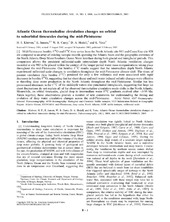Atlantic Ocean thermohaline circulation changes on orbital to suborbital timescales during the mid-Pleistocene
Peer reviewed, Journal article
Permanent lenke
https://hdl.handle.net/1956/402Utgivelsesdato
2003-02-19Metadata
Vis full innførselSamlinger
- Department of Earth Science [1103]
Originalversjon
https://doi.org/10.1029/2001pa000629Sammendrag
Mid-Pleistocene benthic ∂18O and ∂13C time series from the North Atlantic site 983 and Ceara Rise site 928 are compared to an array of existing isotopic records spanning the Atlantic basin and the geographic extremes of the North Atlantic Deep Water/Southern Ocean Water interface during both glacial and interglacial periods. This comparison allows the persistent millennial-scale intermediate depth North Atlantic ventilation changes recorded at site 983 to be placed within the context of the longer period water mass reorganizations taking place throughout the mid-Pleistocene. Our benthic ∂13C results suggest that the intermediate depth North Atlantic experienced millennial-scale changes in ventilation throughout the mid-Pleistocene climate shift. The times of poorest ventilation (low benthic ∂13C) persisted for only a few millennia and were associated with rapid decreases in benthic ∂18O, suggesting that ice sheet decay and melt water induced salinity changes were effective at throttling deep water production in the North Atlantic throughout the mid-Pleistocene. Similar but less pronounced decreases in the ∂13C of the middepth waters also punctuated interglacials, suggesting that large ice sheet fluctuations do not explain all of the observed thermohaline circulation mode shifts in the North Atlantic. Meanwhile, on orbital timescales, glacial deep to intermediate water ∂13C gradients evolved after ~0.95 Ma. Taken together, these observations provide a number of new constraints for understanding the timing and evolution of deep water circulation changes across the mid-Pleistocene.
